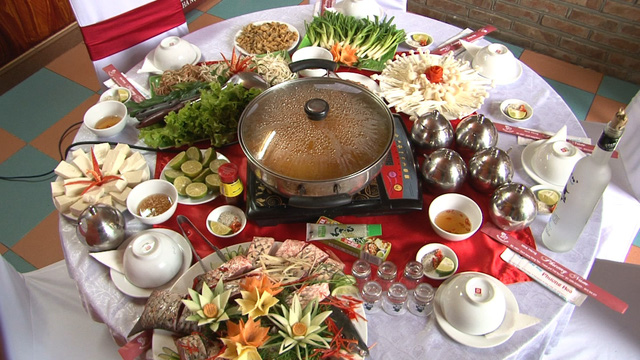Editor’s note: Nguyen Van Cong explains how a fear of ‘losing face’ by people in northern and central Vietnam leads them to buy more food than needed, only to throw away leftovers – a stark contrast to their southern peers.
As in several Asian countries, the importance of 'saving face' – behaving in a way that projects a certain reputation – is paramount in Vietnam.
Cong, who lives and works in the south, introduces himself as being born to a northern Vietnamese mother and a central Vietnamese father, an upbringing which allowed him to closely observe and experience the culture of ‘saving face’ in all three regions.
He says that people in northern and central Vietnam “pay too much attention to etiquette and sometimes make things overcomplicated” when inviting guests to a meal at their houses, especially when compared to those in the southern region.
From his observation and experience, Cong has drawn three main conclusions about the issue in this piece sent to Tuoi Tre (Youth) newspaper.
1. People in the south: simple eating, no showing-off
The menu for a party in the south, particularly in Saigon or the Mekong Delta, usually consists of fewer dishes compared to that for a bash in the north and central regions. The party hosts will make it simple and quick, large ceremonial parties excluded.
Whenever guests drop by for a meal, southerners prepare quick, simple dishes while still focusing on creating a cozy, respectful welcoming atmosphere. For instance, a hotpot, which can be cooked with little preparation, is considered an appropriate meal for visiting guests.
The food may be simple but what matters is the taste – there is no need for complicated and costly preparation.
 |
| A table full of different Vietnamese dishes is seen in this photo illustration. Photo: Tuoi Tre |
However, this is not what I observe in the northern and central regions, where people tend to get over-serious about preparing for visitors.
In these regions, you’re expected to alert your host at least a day in advance if you plan to drop by so that they have enough time to meticulously prepare a feast.
Even when only one or two guests are expected, hosts make it their mission to prepare a menu of at least five to six different courses.
To avoid losing face, people in northern and central Vietnam will try to ensure that they treat their guests to ‘sufficient food.' From the host’s perspective, a meal with too few dishes or an insufficient amount of food indicates a lack of hospitality.
The problem is that such a large meal is rarely finished. To complicate the matter, the host looks at the wasted food with pleasure, considering it a sign that their guest was treated with great hospitality.
The flip side? Leftovers, if inappropriately preserved, go bad and wind up in the trash bin.
Why should people be so wasteful just because they fear losing face?
2. Southern hosts and guests often say no to ceremonious behaviors
One cultural value of the southerners is that they respect relations but seldom treat one another with ceremonious behavior or unnecessary formality. People act toward each other with kindness and openness and rarely displease one another.
This is also true when someone wants to invite guests to their house for a meal. Even wedding invitations are sometimes made via phone call.
Guests also show great respect for their hosts. If they know that the family inviting them for a meal is cash-strapped, they happily exclaim that simple dishes are more than enough.
In other cases, visitors bring their own food and drinks to avoid putting the host in an embarrassing situation. At bigger parties, every participant contributes their share of food. A party needs not to be held at a table and people often sit on the floor.
 |
| People in southern Vietnam throw a party by sitting on the floor. Photo: Khang Cao/Tuoi Tre News |
At meals, southern visitors don’t pretend to be full. Instead, they eat as much as their stomach can fit.
By contrast, those in the northern and central regions maintain formal behavior. Even a host without much money will prepare a feast.
The meal must take place on the dining table and some families even ‘assign’ members to receive the guests and act as an ‘emcee.'
And few guests will eat to the point that they feel really full, even though they’re truly hungry.
3. Southerners love partying, but never waste anything
When it comes to eating and partying, the southerners are careful to prepare the menu so all food will be consumed with no leftovers.
For instance, in northern or central Vietnam, at a party with five people, if a cake is split into six pieces, no one will take the extra share. This won’t happen in the south, where people will eat that extra piece, or put it back to the fridge.
In the northern and central regions, leftover food after parties or wedding ceremonies used to be thrown away as few wanted to share and take home the redundant food.
Luckily, this trend is beginning to change.
Have anything to add to Cong’s story? Comment below or email to ttn@tuoitre.com.vn.





















































